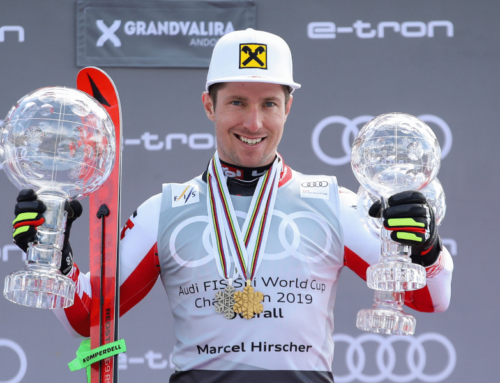‘Race of the First Snow’ lives up to its name

Men’s speed is kicking off this weekend three weeks after its traditional launch. Organizers this week inverted the schedule, which is now super G Saturday and downhill Sunday to better accommodate the weather forecast. Monday is being held as a reserve day in case weather pushes the schedule.
It will be the first time in 24 for years that the Critérium de la Première Neige — which translates to the “Race of the First Snow” — will actually be the first races of the season for speed. All told, this is the 63rd running of the event in Val d’Isere.

Classic cartographer 80s map of the OK Course.
These races will be held on the old course — the OK (Oreiller-Killy) course — which hasn’t been featured on the men’s circuit since 2016 when it was the replacement venue for Beaver Creek. There aren’t more than a few elder statesmen who have raced the course more than once in their World Cup careers. Therefore, with no preamble to the race, scarce few data points on this track, varying degrees of prep among teams, and the ultimate fact that training “pace” reports don’t mean much until you set foot on an actual World Cup track, I am desperately trying to figure how to moneyball this thing. But bare with me.

Let’s jump right into the Americans, who (along with the Germans) are coming off a successful block of speed training at the always-reliable Copper Mountain Speed Center. They got their laps and should have been able to winnow down their quivers and setups to be ready. The annual challenge is that Copper conditions are always so good, that you’re not prepared for the bad. The World Cup is rarely, if ever, prepared to the same level of quality as Copper.
But what the U.S. has learned over nearly a decade of early-season training at the Speed Center is how to use it effectively. Rather than dial equipment to be fast in the unique Copper environment, they’ve learned to work with what they set up on the glaciers earlier in September. Something to suit the “rattle,” which is a hallmark of European speed tracks.
Surprise: Today I got this text from head U.S. men’s speed coach Randy Pelky … “Snow is a lot like Copper.” Note to self: Update moneyball spreadsheet.

On the DH side, this is arguably the U.S.’s deepest team, with four ranked among top 20 in the world and some youthful speed backing the veterans. It’s leaner in super G.
Sadly, the kid that was setting the pace in training for the U.S., Kyle Negomir, will not be racing. Negomir threw down an impressive eighth place in the opening training run on Thursday, but crashed upon arrival in the finish area, sustaining a knee and hand injury. He’s on his way back to the U.S. for evaluation. It’s one thing to be fast in training among a team of high-ranking veterans, it’s altogether another to, at age 22, deliver that pace in your opening training run of the season on a World Cup track. This hurts on many levels.

On the upside, Bryce Bennett, who’s been touch-and-go in training, finished not far behind in 10th on Thursday. The fact that he’s able to turn things up in the race environment speaks to more of a veteran mentality. Also, be on the lookout for Jared Goldberg, who I’m told is skiing better than ever. There’s the consummate veteran in Travis Ganong, who has the ability to access the very highest pace on the World Cup at the flip of a switch. While he trailed in training, do not be fooled. Ryan Cochran-Siegle the able all-rounder was fast here in 2016, and with more speed miles logged on his odometer than any other season lead in. He stands to be better still and the American standout in SG. Sam Dupratt will join the team of five U.S. starters in SG, but will be pushing through some back issue. Come the DH, it’s a deep team of contenders in search of consistent podium performances. Also in the start are Sam Morse and 2016 World Junior Champ Erik Arvidsson after a four-year speed break while racing college.

The Swiss don’t have to look any further than Beat Feuz, who rarely finishes outside the top five. The level of consistency this guy has across all conditions and scenarios is mind-boggling. And yet, every training run looks like a disinformation campaign. Come race day, he finds speed that everyone knows he has, but until that time, he will not show those cards. Bode Miller used to say he wished downhill didn’t have training. because people used to steal some of beyond-bold tactics he would divine in training. Beat Feuz, maybe more than anyone else in the history of the sport, can save his best stuff, untested, for race day and I couldn’t begin to explain how.
This course has a very flat start. Early advantage to those with a powerful acceleration. Look to guys like Aleksander Aamodt Kilde, Kjetil Jansrud and Mauro Caviezel to get to that first split pretty quickly. Caviezel is of course coming off an achilles injury in June, but was quickly back to speed this fall according to his coach, Thomas Stuaffer. (Other injury updates: American Steven Nyman, who ruptured his achilles in August, is on snow, but his return date is still TBD. German Thomas Dressen, second in 2020 DH standings, had hip surgery Nov. 27 and is out until at least March.)
The Swiss team in general should be looking pretty sharp and ready with perhaps the best prep period of any nation, thanks to a tremendous variety of glaciers with suitable speed venues to bounce between. When weather sours at one, there’s always another nearby.
Let’s also take note of Johan Clarey, age 39. A) he’s still racing, and B) he’s third in training. Should he win he would be the oldest racer by far to win a World Cup.

Keep an eye on the Norwegians. The last person to win on this track was Jansrud, who won the super G and the downhill. While Jansrud may not be his full 2016 self, the Norwegians are among the best in the world at casting knowledge throughout the team. If Jansrud is not up to it, you can be sure he’s downloaded every bit of his winning wisdom to his teammates. It would appear Kilde knows what to do with it, as he dramatically outpaced the field in the opening training run.
Austria is pointing towards Vincent Kriechmayer to lead the way. After spending his entire life on Fischer, moved to Head skis and found a different feeling that happens to look fast.
Finally, we’ll see the return of Dominik Paris. This is a skier who I think is long overdue to win a downhill title, but sustained his first major ACL injury last season days before the downhill in Kitzbuhel. I’m curious to see how he will return to action.
Shiffrin back in primetime
The women are set square off for a GS doubleheader in Courchevel. Of course, the big story going into the event is the return of Mikaela Shiffrin, after a three-week hiatus, who will be kicking out in a giant slalom for the first time this season after sitting out the Soelden opener in October. Shiffrin, in a press conference this week, verbalized what many of us had been assuming — that the overall title is out of reach for this season and not in her sights.

Shiffrin, like many racers in the field, had her prep period curtailed due to COVID travel restrictions this offseason. Additionally, her team opted out of September training on the glaciers with its notoriously capricious weather in favor of the long view: a bit more piece of mind at home before taking off for six months. Turns out, September was beautiful and when they arrived Europe in October, it went bad, along with her back. Upshot: She opened her season with 20 days training rather than her habitual 60. Twenty can work for some, like a Federica Brignone, who has never skied over 35 days in summer until last season. But for a creature of repetition and perfection like Mikaela, it’s not going to work — or at least it’s uncharted. Shiffrin finally got the block of GS training that she was hoping for prior to Soelden. She seems happy with the training in Reiteralm, near the Atomic factory, where she was able to rejoin her European-based technician to sort through the latest iterations of equipment that awaited her.
Looking toward the weekend, we’re going to again see multiple races of the same discipline on the same hill, which is rarely the case in a normal season. This year, it’s already happened twice (and would have been thrice had the St. Moritz super Gs not been snowed out). By Day 2, I always think this configuration will play into the hands of the younger skiers trying to get their feet wet, who will get a second crack at the hill.

Paula Moltzan has already provided more than a taste of the pace she is currently wielding in GS, but tempered expectations might be prudent given her start number, which is still somewhere in the 60s. But, if she can finish inside the top 20, by Day 2, there’s a good chance she’ll start among the top 30, and then watch out.
It wasn’t reported at the time, but Nina O’Brien fractured her left thumb in 15 places (not a typo) the day before her start in Lech/Zürs, and she raced … the parallel … where you yank as hard as you can on handles to get out to the gate. So she just jumped right to the top of my badass list. Stunning to me that she competed and competed as well as she did with that kind of injury.

The confidence mercury is rising on that team, and I’m curious to see the influence it will have on AJ Hurt and Keely Cashman, who have the training pace to reach a second run.
But, there’s no reason to think that Marta Bassino is not the favorite, along with 2019 winner Brignone, who has a love/hate relationship with this hill. She’s crashed here as often as she’s finished in GS. If you include her slalom races, she’s batting .250, so there’s the psychological baggage that might go along with that.
Petra Vlhova probably benefited from a little bit of rest after the St. Moritz cancellation, although she did go there. They got out in a hurry and went back to her home in Jasna, where she was able to catch her breath.
I’ve also got my eye on Tessa Worley, who might rise to the occasion on home snow. She’s the best French GS skier of all time, but has never won on home snow. I also expect Alice Robinson to reemerge after a slow start to the season. She, like any of the other GS globe contenders who got a slow start, absolutely have to hit the weekend in top gear. By Sunday, a third of the GS season will have expired, and with it might go some crystal dreams.





















